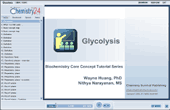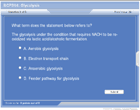Glycolysis
| Topic Review on "Title": |
Release of energy from glucose
Glycolysis is the sequence of reactions that converts glucose into pyruvate with the concomitant production of a relatively small amount of ATP. Glucose is the starting material and two molecules of pyruvate are the end products of the pathway. Subcellular site of the pathway is the cytosol. Glycolysis is a linear pathway of ten enzyme mediated steps.
Phases of glycolysis
Pathway has two phases: Energy investment phase and energy generation phase. Energy investment phase is also called preparatory phase and consists of first five steps. Here the end product is glyceraldehyde - 3 – phosphate. Energy generation phase is also known as payoff phase and consists of last five steps and end products are two pyruvate molecules.
Energy yield from the pathway
It can occur in presence or absence of oxygen. Altogether there are ten steps involved and in aerobic glycolysis net ATP gain is 8 and the pyruvate enters the citric acid cycle, oxidized to CO2 and H2O.
Anaerobic glycolysis
Under anaerobic conditions, net ATP gain is 2 from substrate level phosphorylation. NADH gets accumulated which is reoxidized via lactic acid and alcohol fermentation.
Sources of glucose for glycolysis
Glycogen, dietary disaccharides and monosaccharides also enter the glycolytic pathway, since they are the sources of glucose.
|
| Rapid Study Kit for "Title": |
| Flash Movie |
Flash Game |
Flash Card |
| Core Concept Tutorial |
Problem Solving Drill |
Review Cheat Sheet |
 |
 |
 |
|
| "Title" Tutorial Summary : |
Glycolysis is the sequence of reactions that converts glucose into pyruvate with the concomitant production of a relatively small amount of ATP. Glucose is the starting material and two molecules of pyruvate are the end products of the pathway. Pathway has two phases: Energy investment phase and energy generation phase. Subcellular site of the pathway is the cytosol. It can occur in presence or absence of oxygen. Altogether there are ten steps involved and in aerobic glycolysis net ATP gain is 8 and the pyruvate enters the citric acid cycle. In anaerobic conditions, pyruvate undergoes lactic acid and alcohol fermentation. Glycogen, dietary disaccharides and monosaccharides also enter the glycolytic pathway, since they are the sources of glucose.
|
| Tutorial Features: |
- Basic concept map for metabolism is given.
- Concept map for glycolysis.
- Definitions of useful terms in glycolysis.
- Individual reactions are given.
- Flow chart of feeder pathway is shown.
|
| "Title" Topic List: |
Release of energy from glucose
- Definition
- Facts of glycolysis
- Overview of phases
Phases of glycolysis
- Preparatory phase: I to V steps
- Overview of preparatory phase
- Payoff phase VI to X steps
- Overview of payoff phase
Energy yield from the pathway
- Summary of glycolysis
- Summary of energy released
- Fates of pyruvate
Anaerobic glycolysis
- Lactic acid fermentation
- Alcohol fermentation
- Feeder pathway
Sources of glucose for glycolysis
- Entry of glycogen
- Entry of galactose – a monosaccharide
- Entry of dietary disaccharide
|
See all 24 lessons in college chemistry, including concept tutorials, problem drills and cheat sheets:
Teach Yourself Biochemistry Visually in 24 Hours |



